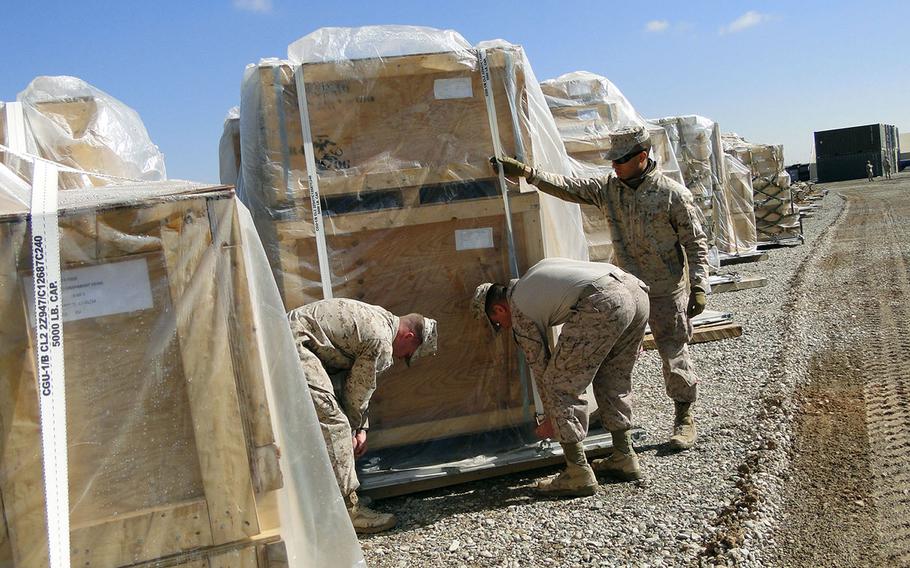
From left, Lance Cpl. Matthew Ford, Cpl. Matthew Pappas and Lance Cpl. Albert Adams, all of Retrograde and Redeployment in Support of Reset and Reconstitution Operations Group, prep a pallet of gear for transport from Camp Leatherneck, Afghanistan, to I Marine Expeditionary Force at Camp Pendleton, Calif. in this photo from February 2014. (Jennifer Hlad/Stars and Stripes)
Only 25 remain, down from a wartime high of more than 800.
Isolated combat outposts and sprawling forward operating bases, 62 in all, were transferred from U.S. and NATO militaries to Afghan forces — or disappeared — over the course of the past year, according to the International Security Assistance Force.
What remain are headquarters elements and logistical hubs.
Enduring bases include the headquarters of the NATO-led mission in Kabul, with regional centers at Bagram Air Field, Kandahar in the south, Mazar-e-Sharif in the north and Herat in the west. Some smaller bases, such as the airfield in Jalalabad, will be used for advising and assisting the Afghan forces.
The tedious work of dismantling, packing and cleaning the bases that were slated for closure was often interrupted by a still potent Taliban insurgency.
In Afghanistan’s volatile east, the insurgents made sure departing Americans knew they intended to continue fighting.
FOB Airborne, in Wardak province, was closed after a six-hour firefight in its last weeks, and FOB Ghazni suffered a ground attack the day U.S. forces were leaving. FOB Shank in Logar province suffered rocket fire and a stubbornly effective threat from improvised explosive devices well into its final month of operation.
“The Taliban want to appear to be driving the U.S. out,” Anthony Cordesman, a strategy expert with the Washington Center for Strategic and International Studies told Stars and Stripes in October. “They’re playing to local tribes ... it strengthens the Taliban image but it gives a broader picture that the government is weak and that they can’t hold the territory.”
In Helmand province in southwestern Afghanistan, a Taliban stronghold, the insurgents barely waited a month after the U.S. Marine and British bases in the region — camps Leatherneck and Bastion — were transferred before launching a 48-hour complex attack.
The Taliban have stepped up attacks in Kabul, which still houses the NATO-led coalition’s headquarters, foreign embassies and foreign aid organizations. By the end of this month, American forces will number around 9,800 as they and NATO allies transition from their 13-year combat mission toward a train and advise mission called Resolute Support.